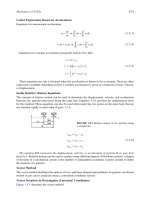maintenance engineering handbook 7th ed, mc grawhill (2008)
Bạn đang xem bản rút gọn của tài liệu. Xem và tải ngay bản đầy đủ của tài liệu tại đây (23.53 MB, 1,244 trang )
MAINTENANCE
ENGINEERING
HANDBOOK
R. Keith Mobley Editor in Chief
Lindley R. Higgins
Darrin J. Wikoff
Seventh Edition
New York Chicago San Francisco Lisbon London Madrid
Mexico City Milan New Delhi San Juan Seoul
Singapore Sydney Toronto
Copyright © 2008, 2002, 1995, 1988, 1977, 1966, 1957 by The McGraw-Hill Companies, Inc. All rights reserved. Manufactured in
the United States of America. Except as permitted under the United States Copyright Act of 1976, no part of this publication may
be reproduced or distributed in any form or by any means, or stored in a database or retrieval system, without the prior written
permission of the publisher.
0-07-164101-7
The material in this eBook also appears in the print version of this title: 0-07-154646-4.
All trademarks are trademarks of their respective owners. Rather than put a trademark symbol after every occurrence of a
trademarked name, we use names in an editorial fashion only, and to the benefit of the trademark owner, with no intention of
infringement of the trademark. Where such designations appear in this book, they have been printed with initial caps.
McGraw-Hill eBooks are available at special quantity discounts to use as premiums and sales promotions, or for use in corporate
training programs. For more information, please contact George Hoare, Special Sales, at or (212)
904-4069.
TERMS OF USE
This is a copyrighted work and The McGraw-Hill Companies, Inc. (“McGraw-Hill”) and its licensors reserve all rights in and to the
work. Use of this work is subject to these terms. Except as permitted under the Copyright Act of 1976 and the right to store and
retrieve one copy of the work, you may not decompile, disassemble, reverse engineer, reproduce, modify, create derivative works
based upon, transmit, distribute, disseminate, sell, publish or sublicense the work or any part of it without McGraw-Hill’s prior
consent. You may use the work for your own noncommercial and personal use; any other use of the work is strictly prohibited. Your
right to use the work may be terminated if you fail to comply with these terms.
THE WORK IS PROVIDED “AS IS.” McGRAW-HILL AND ITS LICENSORS MAKE NO GUARANTEES OR WARRANTIES
AS TO THE ACCURACY, ADEQUACY OR COMPLETENESS OF OR RESULTS TO BE OBTAINED FROM USING THE
WORK, INCLUDING ANY INFORMATION THAT CAN BE ACCESSED THROUGH THE WORK VIA HYPERLINK OR
OTHERWISE, AND EXPRESSLY DISCLAIM ANY WARRANTY, EXPRESS OR IMPLIED, INCLUDING BUT NOT LIMITED
TO IMPLIED WARRANTIES OF MERCHANTABILITY OR FITNESS FOR A PARTICULAR PURPOSE. McGraw-Hill and its
licensors do not warrant or guarantee that the functions contained in the work will meet your requirements or that its operation will
be uninterrupted or error free. Neither McGraw-Hill nor its licensors shall be liable to you or anyone else for any inaccuracy, error
or omission, regardless of cause, in the work or for any damages resulting therefrom. McGraw-Hill has no responsibility for the
content of any information accessed through the work. Under no circumstances shall McGraw-Hill and/or its licensors be liable for
any indirect, incidental, special, punitive, consequential or similar damages that result from the use of or inability to use the work,
even if any of them has been advised of the possibility of such damages. This limitation of liability shall apply to any claim or cause
whatsoever whether such claim or cause arises in contract, tort or otherwise.
DOI: 10.1036/0071546464
We hope you enjoy this
McGraw-Hill eBook! If
you’d like more information about this book,
its author, or related books and websites,
please click here.
Professional
Want to learn more?
iii
CONTENTS
Contributors ix
Foreword xi
Preface xii
SI Units and Conversion Factors xiii
Section 1 Organization and Management of the Maintenance
Function
Chapter 1. Redefining Maintenance—Delivering Reliability
Scott Franklin
1.3
Chapter 2. Introduction to the Theory and Practice of Maintenance
R. Keith Mobley
1.9
Chapter 3. Maintenance and Reliability Engineering
R. Keith Mobley
1.17
Chapter 4. Cooperative Partnerships
Jeff Nevenhoven
1.23
Chapter 5. Effective Maintenance Organizations
Randy Heisler
1.31
Chapter 6. Operating Policies of Effective Maintenance
Tom Dabbs
1.39
Chapter 7. Six Sigma Safety: Applying Quality Management Principles
to Foster a Zero-Injury Safety Culture
Michael Williamsen
1.55
Section 2 The Horizons of Maintenance Management
Chapter 1. Corrective Maintenance
R. Keith Mobley
2.3
Chapter 2. Reliability-Based Preventive Maintenance
R. Keith Mobley
2.7
Chapter 3. Predictive Maintenance
R. Keith Mobley
2.19
For more information about this title, click here
Chapter 4. Reliability-Centered Maintenance
Darrin Wikoff
2.35
Chapter 5. Total Productive Maintenance
R. Keith Mobley
2.41
Chapter 6. Maintenance Repair and Operations—Storeroom Excellence
Wally Wilson
2.59
Chapter 7. Computerized Planning and Scheduling
Thomas A. Gober
2.79
Chapter 8. Computer-Based Maintenance Management Systems
R. Keith Mobley
2.91
Section 3 Engineering and Analysis Tools
Chapter 1. Economics of Reliability
Robert Fei
3.3
Chapter 2. Work Measurement
Bruce Wesner
3.19
Chapter 3. Rating and Evaluating Maintenance Workers
Robert (Bob) Call
3.65
Chapter 4. Work Simplification in Maintenance
Al Emeneker
3.89
Chapter 5. Estimating Repair and Maintenance Costs
Tim Kister
3.107
Chapter 6. Key Performance Indicators
John Cray
3.121
Chapter 7. Maintenance Engineer’s Toolbox
Shon Isenhour
3.133
Chapter 8. Root Cause Analysis
Darrin Wikoff
3.153
Section 4 Maintenance of Plant Facilities
Chapter 1. Maintenance of Low-Sloped Membrane Roofs
Donald R. Mapes and Dennis J. McNeil
4.3
Chapter 2. Concrete Industrial Floor Surfaces: Design, Installation,
Repair, and Maintenance
Robert F. Ytterberg
4.17
iv
CONTENTS
Chapter 3. Maintenance and Cleaning of Brick Masonry Structures
Brian E. Trimble
4.27
Chapter 4. Maintenance of Elevators and Special Lifts
Jerry Robertson
4.43
Chapter 5. Air-Conditioning Equipment
Martin A. Scicchitano
4.53
Chapter 6. Ventilating Fans and Exhaust Systems
R. Keith Mobley
4.87
Chapter 7. Dust-Collecting and Air-Cleaning Equipment
Lee Twombly and Samuel G. Dunkle
4.111
Section 5 Maintenance of Mechanical Equipment
Chapter 1. Plain Bearings
R. Keith Mobley
5.3
Chapter 2. Rolling-Element Bearings
Daniel R. Snyder
5.19
Chapter 3. Flexible Couplings for Power Transmission
Terry Hall
5.45
Chapter 4. Chains for Power Transmission
Frank B. Kempf
5.73
Chapter 5. Cranes: Overhead and Gantry
William S. Chapin
5.83
Chapter 6. Chain Hoists
R. C. Dearstyne
5.91
Chapter 7. Belt Drives
Dan Parsons and Tim Taylor
5.99
Chapter 8. Mechanical Variable-Speed Drives
Carl March
5.145
Chapter 9. Gear Drives and Speed Reducers
Robert G. Smith
5.161
Chapter 10. Reciprocating Air Compressors
R. Keith Mobley
5.185
Chapter 11. Valves
Terry Hall
5.197
Chapter 12. Pumps: Centrifugal and Positive Displacement
Carl March
5.213
CONTENTS v
Section 6 Maintenance of Electrical Equipment
Chapter 1. Electric Motors
Shon Isenhour
6.3
Chapter 2. Maintenance of Motor Control Components
Shon Isenhour
6.39
Chapter 3. Maintenance of Industrial Batteries (Lead-Acid,
Nickel-Cadmium, Nickel-Iron)
Terry Hall
6.79
Section 7 Instruments and Reliability Tools
Chapter 1. Mechanical Instruments for Measuring Process Variables
R. Keith Mobley
7.3
Chapter 2. Electrical Instruments for Measuring, Servicing, and Testing
R. Keith Mobley
7.43
Chapter 3. Vibration: Its Analysis and Correction
R. Keith Mobley
7.69
Chapter 4. An Introduction to Thermography
R. Keith Mobley
7.105
Chapter 5. Tribology
R. Keith Mobley
7.127
Section 8 Lubrication
Chapter 1. The Organization and Management of Lubrication
F. Alverson, T. C. Mead, W. H. Stein, and A. C. Witte
8.3
Chapter 2. Lubricating Devices and Systems
Duane C. Allen
8.13
Chapter 3. Planning and Implementing a Good Lubrication Program
R. Keith Mobley
8.27
Section 9 Chemical Corrosion Control and Cleaning
Chapter 1. Corrosion Control
Denny Bardoliwalla and Klaus Wittel
9.3
Chapter 2. Industrial Chemical Cleaning Methods
Robert Haydu, W. Emerson Brantley III, and Jerry Casenhiser
9.17
vi
CONTENTS
Chapter 3. Painting and Protective Coatings
Bryant (Web) Chandler
9.35
Chapter 4. Piping
Tyler G. Hicks
9.55
Chapter 5. Scaffolds and Ladders
Colin P. Bennett
9.91
Section 10 Maintenance Welding
Chapter 1. Arc Welding in Maintenance
J. E. Hinkel
10.3
Chapter 2. Gas Welding in Maintenance
Engineers of L-TEC Welding and Cutting Systems
10.63
Index
I.1
CONTENTS
vii
ABOUT THE EDITORS
R. KEITH MOBLEY is principal of Life Cycle Engineering in Knoxville, Tennessee.
L
INDLEY R. HIGGINS was an engineering consultant and senior editor of Factory
magazine.
D
ARRIN J. WIKOFF is a senior reliability consultant in Charleston, South Carolina
specializing in project management, business process reliability engineering,
reliability-centered maintenance, and CMMS/eAM implementations.
Copyright © 2008, 2002, 1995, 1988, 1977, 1966, 1957 by The McGraw-Hill Companies, Inc.
Click here for terms of use.
CONTRIBUTORS
F. Alverson Group Leader, Texaco, Inc., Research & Development Department, Port Arthur, Tex. (SEC. 8, CHAP.1)
Duane C. Allen Consultant, LubeCon Systems, Inc., Fremont, Mich. (SEC.8,CHAP.2)
Denny Bardoliwalla Vice President of Research and Technology, Oakite Products, Inc., Berkeley Heights,
N.J. (SEC.9, CHAP.1)
W. Emerson Brantley III Marketing Director, Bronz-Glow Coatings Corp., Jacksonville, Fla. (SEC.9,
CHAP.2)
Colin P. Bennett Scaffolding Consultant (SEC.9, CHAP.5)
Robert (Bob) Call Principal, Life Cycle Engineering, Inc., Charleston, S.C. (SEC.3,CHAP.3)
Bryant (Web) Chandler Cannon Sline, Philadelphia, Pa. (SEC.9, CHAP.3)
William S. Chapin Director of Engineering, Crane & Hoist Division, Dresser Industries, Inc., Muskegon,
Mich. (SEC.5,CHAP.5)
Jerry Casenhiser Senior Chemist, Bronz-Glow Coatings Corp., Jacksonville, Fla. (SEC.9, CHAP.2)
John Cray Managing Principal, Life Cycle Engineering Inc., Charleston, S.C. (SEC.3,CHAP.6)
Tom Dabbs Vice President Life Cycle Engineering, Inc., Charleston, S.C. (SEC.1,CHAP.6)
R. C. Dearstyne Manager, Product Application, Columbus McKinnon Corporation, Amherst, N.Y. (SEC.5,
CHAP.6)
Samuel G. Dunkle Manager, Electrostatic Precipitators and Fabric Collectors, SnyderGeneral
Corporation (American Air Filter), Louisville, Ky. (SEC.4,CHAP.7)
Al Emeneker Work Control SME, Life Cycle Engineering, Inc., Charleston, S.C. (SEC.3,CHAP.4)
Engineers of L-TEC Welding and Cutting Systems Florence, S.C. (SEC.10, CHAP.2)
Robert Fei Managing Principal, Life Cycle Engineering, Inc., Charleston, S.C. (SEC.3,CHAP. 1)
Scott Franklin Senior V.P., Life Cycle Engineering, Inc., Charleston, S.C. (SEC.1,CHAP.1)
Thomas A. Gober Maintenance Planning Consultant, Life Cycle Engineering, Inc., Charleston, S.C.
(SEC.2,CHAP.7)
Tyler G. Hicks Mechanical Engineer, Rockville Centre, N.Y. (SEC.9, CHAP. 4)
Terry Hall Reliability Engineer, Life Cycle Engineering, Inc., Charleston, S.C. (SEC.5,CHAPS. 3 & 11; SEC.6,
CHAP.3)
Robert Haydu NACE, ASHRAE President and Chief Chemist, Bronz-Glow Coatings Corp., Jacksonville,
Fla. (SEC.9, CHAP.2)
Randy Heisler Managing Principal, Life Cycle Engineering, Inc., Charleston, S.C. (SEC.1,CHAP.5)
J. E. Hinkel The Lincoln Electric Company, Cleveland, Ohio (SEC.10, CHAP.1)
Shon Isenhour Principal, Life Cycle Engineering, Inc., Charleston, S.C. (SEC. 3, CHAP. 7; SEC. 6, CHAPS. 1 & 2)
Frank B. Kempf Division Marketing Manager, Drives & Components Division, Morse Industrial
Corporation, a subsidiary of Emerson Electric Company, Ithaca, N.Y. (SEC.5,CHAP.4)
ix
Copyright © 2008, 2002, 1995, 1988, 1977, 1966, 1957 by The McGraw-Hill Companies, Inc.
Click here for terms of use.
Tim Kister Maintenance Planning SME, Life Cycle Engineering, Inc., Charleston, S.C. (SEC.3,CHAP.5)
Louisville, Ky. (SEC.4,CHAP.7)
T. C. Mead Senior Technologist (Ret.), Texaco, Inc., Research & Development Department, Port Arthur, Tex.
(SEC.8,CHAP.1)
Donald R. Mapes Building Technology Associates, Inc., Glendale, Ariz. (SEC.4,CHAP.1)
Dennis J. McNeil Construction Consultants, Inc., Homewood, Ill. (SEC.4,CHAP.1)
R. Keith Mobley Principal, Life Cycle Engineering, Inc., Charleston, S.C. (SEC.1,CHAPS.2&3;SEC.2,
CHAPS. 1, 2, 3, 5 & 8; SEC.4,CHAP.6;SEC.5,CHAP. 1 & 10; SEC.7,CHAPS. 1, 2, 3, 4 & 5; SEC.8,CHAP.3)
Carl March Reliability Engineer Life Cycle Engineering, Inc., Charleston, S.C. (SEC.5,CHAPS. 8 & 12)
Jeff Nevenhoven Senior Consultant,Life Cycle Engineering, Inc.,Charleston, S.C. (SEC.1,CHAP.4)
Dan Parsons Application Engineer, Gates Corporation, Denver, Colo. (SEC. 5, CHAP.7)
Jerry Robertson Maintenance Quality Engineer, Otis Elevator Company, Farmington, Conn. (SEC.4,CHAP.4)
Martin A. Scicchitano Carrier Air Conditioning Company, Syracuse, N.Y. (SEC.4,CHAP.5)
W. H. Stein Group Leader, Texaco, Inc., Research & Development Department, Port Arthur, Tex. (SEC.8,
CHAP.1)
Robert G. Smith Director of Engineering, Philadelphia Gear Corporation, King of Prussia, Pa. (SEC.5,
CHAP.9)
Daniel R. Snyder SKF USA, Inc., King of Prussia, Pa. (SEC.5,CHAP.2)
Tim Taylor Application Engineer, Gates Corporation, Denver, Colo. (SEC. 5, CHAP.7)
Brian E. Trimble E.I.T., Brick Institute of America, Reston, Va. (SEC.4,CHAP.3)
Lee Twombly Manager, Scrubber and Mechanical Collectors, SnyderGeneral Corporation (American
Air Filter), Louisville, Ky. (SEC. 4, CHAP.7)
Bruce Wesner Managing Principal, Life Cycle Engineering, Inc., Charleston, S.C. (SEC.3,CHAP.2)
Darrin Wikoff Principal, Life Cycle Engineering, Inc., Charleston, S.C. (SEC. 2, CHAP. 4; SEC.3,CHAP.8)
Michael Williamsen Senior Consultant, Core Media Training Solutions, Portland, Oreg. (SEC.1,CHAP.7)
Wally Wilson Materials SME, Life Cycle Engineering, Inc., Charleston, S.C. (SEC.2,CHAP.6)
Klaus Wittel Manager of Technology Transfer, Oakite Products, Inc., Berkeley Heights, N.J. (SEC.9, CHAP.1)
A. C. Witte Consultant, Texaco, Inc., Research & Development Department, Port Arthur, Tex. (SEC.8,CHAP.1)
Robert F. Ytterberg President, Kalman Floor Company, Evergreen, Colo. (SEC.4,CHAP.2)
x
CONTRIBUTORS
FOREWORD
Some engineering fields change dramatically from year to year, with radical breakthroughs in
technology happening often. These fields may have hundreds or more papers and texts published
each year on the latest best practices. Maintenance engineering is a field which, for the most part,
hasn’t fundamentally changed much over the years. And there aren’t many sources for the latest
information or best practices.
But in recent years, maintenance engineering has, more and more, put an emphasis on true reli-
ability. A business which is asset-intensive, such as manufacturing, relies on a reliability-centered
field of engineering to be successful. In my opinion, reliability engineering itself has become a tech-
nology used for the purpose of improving manufacturing capacity, without capital investment.
The Maintenance Engineering Handbook has long been regarded as the premier source for
expertise on maintenance theory and practices for any industry. This text has been considered
invaluable and now, this latest edition defines those practices that are critical to developing an
effective reliability engineering function within your business.
This text is no longer just about mechanical, electrical, and civil maintenance engineering.
Instead, the seventh edition also focuses on recognized and proven best practices in maintenance,
repair, and overhaul (MRO) inventory management, root-cause analysis, and performance manage-
ment. Keith Mobley, the editor in chief of this text, has more than 35 years of direct experience in
corporate management, process and equipment design, and reliability-centered maintenance
methodologies. For the past 16 years, he has helped hundreds of clients across the globe achieve
and sustain world-class performance through the implementation of maintenance and reliability
engineering principles.
You may spend your career worrying about excessive downtime and high maintenance costs as
a result of repetitive failures. As a fellow veteran maintenance and reliability engineer, I encourage
you to recognize that this field is changing and improvements are being made that empower today’s
business leaders. This text can help you reap the benefits of those changes so that your hard work
produces the best possible results.
J
AMES R. FEI, PE
CEO, Life Cycle Engineering, Inc.
Charleston, S.C.
xi
Copyright © 2008, 2002, 1995, 1988, 1977, 1966, 1957 by The McGraw-Hill Companies, Inc.
Click here for terms of use.
xii
PREFACE
This “Maintenance Engineering Handbook” is written, almost exclusively, by those people who have
had to face the acute never-ending problems of equipment failures, repairs, and upkeep, day by day,
hour by hour, midnight shift by midnight shift. They understand better than most the extraordinary
demands that every maintenance manager, planner, and craftsperson must face and overcome to meet
the everchanging maintenance requirements of today’s plant.
It is the function of “Maintenance Engineering Handbook” to pass along invention, ingenuity, and
a large dose of pure basic science to you, the user. This then is your key, your guide, and your chief
support in the tempestuous battle of Maintenance in the days and years ahead.
Lindley R. Higgins, as editor-in-chief of the first five editions of this handbook, established a
standard for excellence that we have attempted to maintain in this seventh edition. Through the excel-
lent help of maintenance professionals, we have updated those sections that were in the earlier
editions and have added new topics that we believe will help you survive in the battle against
excessive downtime, high maintenance costs, and the myriad other problems that you as a
maintenance professional must face each day.
R. K
EITH MOBLEY
Copyright © 2008, 2002, 1995, 1988, 1977, 1966, 1957 by The McGraw-Hill Companies, Inc.
Click here for terms of use.
SI UNITS AND
CONVERSION FACTORS
ACCELERATION
feet per second per second = 30.48 centimeters per second per second
= 0.3048 meters per second per second
free fall (standard) = 9.8067 meters per second per second
kilometers per hour per second = 27.778 centimeters per second per second
= 0.9113 feet per second per second
= 0.27778 meters per second squared
ANGULAR
circumferences = 6.283 radians
degrees = 1.111 grade
= 0.017453 radians
degrees per second = 0.017453 radians per second
= 0.16667 revolutions per minute
= 0.0027778 revolutions per second
minutes = 0.002909 radians
radians = 57.296 degrees (angular)
radians per second = 57.296 degrees per second (angular)
= 9.549 revolutions per minute
revolutions per minute = 6 degrees per second
= 0.01472 radians per second
AREA
acres = 43560 square feet
= 4046.9 square meters
= 0.40469 hectares
circular mils = 0.000007854 square inches
hectares = 2.471 acres
= 107639 square feet
= 10000 square meters
square centimeters = 0.155 square inches
square feet = 0.000022956 acres
= 0.092903 square meters
xiii
Copyright © 2008, 2002, 1995, 1988, 1977, 1966, 1957 by The McGraw-Hill Companies, Inc.
Click here for terms of use.
square inches = 6.4516 square centimeters
square kilometers = 247.1 acres
= 0.3861 square miles
square meters = 0.0002471 acres
= 10.764 square feet
square miles = 640 acres
= 2.59 square kilometers
square yards = 0.00020661 acres
= 0.83613 square meters
CANDLEPOWER
foot candles = 10.764 lumens per square meter
CAPACITY, DISPLACEMENT
cubic inches per revolution = 0.01639 liters per revolution
= 16.39 milliliters per revolution
DENSITY, MASS/VOLUME
grams per cubic centimeter = 0.001 kilograms per cubic meter
= 0.03613 pounds per cubic inch
= 62.427 pounds per cubic foot
pounds-mass per cubic foot = 16.018 kilograms per cubic meter
pounds per cubic foot = 0.016018 grams per cubic centimeter
= 16.018 kilograms per cubic meter
= 0.0005787 pounds per cubic inch
pounds per cubic inch = 27.68 grams per cubic centimeter
= 27.68 kilograms per cubic meter
= 1728 newtons per meter
ENERGY AND WORK
British thermal units = 1055 joules
British thermal units per second = 1.055 watts
British thermal units per minute = 0.02358 horsepower
= 17.58 watts
British thermal units per hour = 0.2931 watts
calories = 0.0039683 British thermal units
= 3.088 foot-pounds
= 4.1868 joules
= 0.4265 kilogram-meters
= 0.001163 watt-hours
ergs = 0.0000001 joules
xiv SI UNITS AND CONVERSION FACTORS
foot-pounds-force = 0.001285 British thermal units
= 0.3238 calories
= 0.000000505 horsepower hours
= 1.3558 joules
= 0.0003238 kilocalories
= 0.13825 kilogram-force meters
= 3.766E-07 kilowatt hours
horsepower = 42.43 British thermal units per minute
= 33000 foot-pounds-force per minute
= 550 foot-pounds-force per second
= 10.69 kilocalories per minute
= 0.7457 kilowatts
= 1.0139 horsepower (metric)
= 745.7 watts
horsepower-boiler = 33479 British thermal units per horse
= 9.8095 kilowatts
= 34.5 pounds of water evaporated per hour at 212°F
horsepower hours = 2.545 British thermal units
= 1980000 foot-pounds-force
= 2684500 joules
= 641.5 kilocalories
= 273200 kilogram-force meters
= 0.7457 kilowatt hours
joules = 0.0009484 British thermal units
= 0.239 calories
= 0.73756 foot-pounds-force
= 0.00027778 watt-hours
kilowatts = 56.92 British thermal units per minute
= 44254 foot-pounds-force per minute
= 737.6 foot-pounds-force per second
= 1.341 horsepower
= 14.34 kilocalories per minute
kilowatt hours = 3413 British thermal units
= 2655000 foot-pounds-force
= 1.341 horsepower hours
= 3.6 joules
= 860 kilocalories
= 367100 kilograms-force meters
pounds-force = 0.45359 kilograms-force
= 4.4482 newtons
tons of refrigeration = 12000 British thermal units per hour
= 288000 British thermal units per 24 hours
watts = 0.
05691 British thermal units per minute
= 0.73756
foot-pounds-force per second
= 44
.254 foot-pounds-force per minute
= 0.001341 horsepower
= 1 joules per second
= 0.01434 kilocalories per minute
watt-hours = 3.413 British thermal units
= 2665 foot-pounds-force
= 0.001341 horsepower hours
= 3600 joules
= 0.8604 kilocalories
= 367.1 kilograms-force-meters
SI UNITS AND CONVERSION FACTORS xv
There are several definitions of the Btu, and the values of applicable and/or equivalent factors may
vary slightly depending on the definition used. For this reason, three or four significant figures are
given on this page, and in most cases provide a value near to most definitions of the Btu. However,
as always in making calculations of high accuracy, one should reference the appropriate lists and
handbooks of standards.
ENERGY/AREA TIME
Btu/cubic feet second = 11348 watts per square meter
Btu/cubic feet hour = 3.1525 watts per square meter
FLOW RATE MASS
pounds per minute = 0.4536 kilograms per minute
FLOW RATE VOLUME
cubic feet per minute = 471.9 cubic centimeters per second
= 0.0004719 cubic meters per second
= 1.699 cubic meters per hour
= 0.4719 liters per second
= 0.2247 gallons (US) per second
= 62.32 pounds of water per minute (at 68°F)
cubic feet per second = 0.028317 cubic meters per second
= 1.699 cubic meters per minute
= 101.9 cubic meters per hour
= 448.8 gallons (US) per minute
= 646315 gallons (imp) per hour
= 28.32 liters
cubic meters per hour = 0.016667 cubic meters per minute
= 0.00027778 cubic meters per second
= 4.4033 gallons (US) per minute
= 0.27778 liters per second
cubic meters per second = 3600 cubic meters per hour
= 15850 gallons (US) per minute
gallons (US) per minute = 0.00006309 cubic meters per second
= 0.0037854 cubic meters per minute
= 0.2771 cubic meters per hour
= 0.002228 cubic feet per second
= 8.021 cubic feet per hour
= 0.06309 liters per second
liters per minute = 0.0005885 cubic feet per second
= 0.01667 liters per second
= 0.004403 gallons (US) per second
= 0.26418 gallons (US) per minute
= 0.003666 gallons (imp) per minute
liters per second = 0.001 cubic meters per second
= 0.06 cubic meters per minute
= 3.6 cubic meters per hour
xvi SI UNITS AND CONVERSION FACTORS
= 60 liters per minute
= 15.85 gallons (US) per minute
= 13.2 gallons (imp) per minute
pounds of water per minute at 60°F = 7.5667 cubic centimeters per second
= 0.0002675 cubic feet per second
= 0.00045398 cubic meters per minute
= 0.0075599 kilograms per second
standard cubic feet per minute = 1.6957 cubic meters per hour at STP
= 0.47103 liters per second at STP
stokes = 0.001076 square feet per second
= 0.0001 square meters per second
tons (short) of water per 24 hours at 60°F = 1.338 cubic feet per hour
= 0.03789 cubic meters per hour
= 0.1668 gallons (US) per minute
= 83.333 pounds of water per hour
FORCE
dynes = 0.00001 newtons
grams-force = 0.0098066 newtons
kilograms-force = 9.8066 newtons
= 2.2046 pounds-force
kilopounds = 9.807 newtons
= 1 kilograms-force
= 2.2046 pounds-force
= 70.932 poundals
= 0.002205 kips
kips = 4448 newtons
= 453.6 kilograms-force
= 1000 pounds-force
= 32174 poundal
= 453.6 kilopond
grams-force per centimeter = 98.07 newtons per meter
= 0.0056 pounds-force per inch
kilograms-force per meter = 9.8066 newtons
= 0.6721 pounds-force per foot
newtons = 100000 dynes
= 0.10197 kilograms-force
= 7.233 poundals
= 0.2248 pounds-force
poundals = 0.13826 newtons
pounds-force = 4.448 newtons
LENGTH
centimeters = 0.3937 inches
fathoms = 6 feet
= 1.8288 meters
SI UNITS AND CONVERSION FACTORS xvii
feet = 30.48 centimeters
= 12 inches
= 0.3048 meters
= 0.3333 yards
inches = 2.54 centimeters
= 0.0254 meters
= 25.4 millimeters
= 25.4 micrometers
kilometers = 3280.8 feet
= 0.62137 miles
meters = 3.2808 feet
= 39.37 inches
= 1.0936 yards
micrometers = 0.000001 meters
millimeters = 0.03937 inches
mills = 0.0254 millimeters
miles = 5280 feet
= 1.6093 kilometers
= 1609.3 meters
= 1760 yards
statute miles = 1.609 kilometers
yards = 0.9144 meters
MASS/WEIGHT
drams (avoir) = 27.344 grains
= 1.7718 grams
= 0.0625 ounces
grains = 0.0648 grams
= 0.0022857 ounces (avoir)
grams = 15.432 grains
= 0.035274 ounces (avoir)
= 0.0022046 pounds (avoir)
kilograms = 2.2046 pounds
= 0.0011023 tons (short)
metric tons (tonnes) = 1000 kilograms
= 2204.6 pounds
ounces (avoir) = 16 drams (avoir)
= 437.5 grains
= 28.3495 grams
= 0.02835 kilograms
= 0.0625 pounds-avoir
= 0.0000279 tons (long)
= 0.00002835 metric tons
pounds (avoir) = 256 drams (avoir)
= 7000 grains
= 453.59 grams
= 0.45359 kilograms
xviii SI UNITS AND CONVERSION FACTORS
= 16 ounces (avoir)
= 0.00045359 metric tons
= 0.00044643 tons (long)
= 0.0005 tons (short)
tons (long) = 1016 kilograms
= 1.016 metric tons
= 2240 pounds-avoir
= 1.12 tons (short)
tons (short) = 907.18 kilograms
= 2000 pounds-avoir
= 0.89286 tons (long)
= 0.9072 metric tons
short ton = 0.9072 metric ton/tonne
POWER
Btu/hour = 0.2931 watt
Btu/second = 1055 watt
Horsepower = 0.746 kilowatt
PRESSURE AND STRESS
atmosphere = 1.01325 bars
= 76 centimeters of mercury at 32ЊF
= 33.96 feet of water at 68ЊF
= 29.921 inches of mercury at 32ЊF
= 1.0332 kilograms-force per square centimeter
= 103322 kilograms-force per square meter
= 101.325 kilopascals
= 14.696 pounds-force per square inch
= 1.0581 tons-force (short) per square foot
= 760 torr
bars = 100 kilopascals
centimeters of mercury = 0.013158 atmospheres
= 0.01333 bars
= 0.4468 feet of water at 68°F
= 5.362 inches of water at 68°F
= 0.19337 kilograms-force per square centimeter
= 27.85 pounds-force per square inch
= 10 torr
feet of water (at 68°F) = 0.02945 atmospheres
= 0.02984 bars
= 0.8811 inches of mercury (at 0°C)
= 0.03042 kilograms-force per square centimeter
= 2.984 kilopascals
= 0.4328 pounds-force per square inch
= 62.32 pounds-force per square foot
SI UNITS AND CONVERSION FACTORS xix
inches of mercury at 0°C = 0.00342 atmospheres (standard)
= 0.033864 bars
= 1.135 feet of water at 68°F
= 13.62 inches of water at 68°F
= 0.034532 kilograms-force per square centimeter
= 345.32 kilograms-force per square meter
= 3.3864 kilopascals
= 25.4 millimeters of mercury
= 70.73 pounds-force per square foot
= 0.4912 pounds-force per square inch
inches of water at 68°F = 0.002454 atmosphere
= 0.002487 bars
= 0.07342 inches of mercury
= 0.002535 kilograms-force per square centimeter
= 0.2487 kilopascals
= 0.577 ounces-force per square inch
= 5.193 pounds-force per square foot
= 0.03606 pounds-force per square inch
kilograms-force per square centimeter = 0.9678 atmospheres
= 0.98066 bars
= 32.87 feet of water at 68°F
= 28.96 inches of mercury at 0°C
= 98.066 kilopascals
= 2048 pounds-force per square foot
= 14.223 pounds-force per square inch
kilograms-force per square millimeter = 1000000 kilograms-force per square meter
= 9.8066 megapascals
kilograms per square meter = 9.807 pascals
kilopascals = 10000 dynes per square centimeter
= 0.3351 feet of water at 68°F
= 0.2953 inches of mercury at 32°F
= 4.021 inches of water at 68°F
= 0.010197 kilograms-force per square centimeter
= 1000 pascals
= 0.145 pounds-force per square inch
kips per square inch = 6894.8 kilopascals
= 70.
307 kilograms-force per square centimeter
= 68.94
bars
= 1000 pounds per square inch
megapascals = 0.10197 kilograms-force per square millimeter
= 10.197 kilograms-force per square centimeter
= 1000 kilopascals
= 1000000 pascals
= 145 pounds-force per square inch
millibars = 100 pascals
millimeters of mercury at 0°C = 0.0013332 bars
= 0.00468 feet of water at 68°F
= 0.03937 inches of mercury
= 0.53616 inches of water at 68°F
= 0.0013595 kilograms per square centimeter
= 133.32 pascals
= 0.0193368 pounds per square inch
xx SI UNITS AND CONVERSION FACTORS
ounces-force per square inch = 4.395 grams-force per square centimeter
= 43.1 pascals
= 0.0625 pounds-force per square inch
pascals = 0.00001 bars
= 10 dynes per square centimeter
= 0.010197 grams-force per square centimeter
= 0.000010197 kilograms-force per square centimeter
= 0.001 kilopascals
= 1 newtons per square meter
pascals = 0.000145 pounds-force per square inch
poise = 100 centipoises
= 0.1 pascal-seconds
= 0.0020886 pound-force-seconds per square foot
= 0.06721 pounds per foot-second
pounds-force per square foot = 0.01605 feet of water at 68°F
= 0.0004882 kilograms-force per square centimeter
= 0.004788 kilopascals
= 47.88 pascals
= 0.0069444 pounds-force per square inch
pounds-force per square inch = 0.06805 atmospheres
= 2.311 feet of water at 68°F
= 27.73 inches of water at 68°F
= 2.036 inches of mercury at 0°F
= 0.07031 kilograms force per square centimeter
= 6.8948 kilopascals
pounds per square foot = 4.8824 kilograms per square meter
pounds per square inch = 6895 pascals
= 6.895 kilopascals
= 0.006895 megapascals
THERMAL CONDUCTIVITY
Btu
.
inch
.
hour
.
feet
2
.
°F = 0.1442 watt per meter
2
°K
TORQUE: BENDING MOMENT
pound feet = 1.356 newton meters
kilogram meters = 9.807 newton meters
VELOCITY
centimeters per second = 0.03281 feet per second
= 1.9685 feet per minute
= 0.02237 miles per hour
= 0.036 kilometers per hour
= 0.6 meters per minute
SI UNITS AND CONVERSION FACTORS xxi
feet per minute = 0.508 centimeters per second
= 0.01829 kilometers per hour
= 0.3048 meters per minute
= 0.00508 meters per second
= 0.01136 miles per hour
feet per second = 30.48 centimeters per second
= 1.097 kilometers per hour
= 18.29 meters per minute
= 0.3048 meters per second
= 0.6818 miles per hour
international knots = 0.5144 meters per second
= 1.1516 miles per hour
kilometers per hour = 27.778 centimeters per second
= 0.9113 feet per second
= 54.68 feet per minute
= 0.53996 international knots
= 16.667 meters per minute
= 0.27778 meters per second
= 0.6214 miles per hour
kilometers per second = 37.28 miles per minute
meters per minute = 1.6667 centimeters per second
= 3.2808 feet per minute
= 0.05468 feet per second
= 0.06 kilometers per hour
= 0.03728 miles per hour
meters per second = 196.8 feet per minute
= 3.281 feet per second
= 3.6 kilometers per hour
= 0.06 kilometers per minute
= 2.237 miles per hour
= 0.03728 miles per minute
miles per hour = 44.7 centimeters per second
= 88 feet per minute
= 1.4667 feet per second
= 0
.
869
international knots
= 1.6093 kilometers per hour
= 26.82 meters per minute
VOLUME
acre-feet = 43.56 cubic feet
= 325851 gallons (US)
= 1233.5 cubic meters
barrels (US liquid) = 31.5 gallons (US)
barrels (oil) = 0.11924 cubic meters
= 42 gallons of oil
= 0.15899 cubic meters
cubic centimeters = 0.06102 cubic inches
= 0.000035315 cubic feet
= 0.000001308 cubic yards
= 0.0002642 gallons (US)
= 0.00022 gallons (imp)
= 0.001 liters
xxii SI UNITS AND CONVERSION FACTORS
cubic feet = 28317 cubic centimeters
= 0.028317 cubic meters
= 1728 cubic inches
= 0.03704 cubic yards
= 7.4805 gallons (US)
= 6.229 gallons (imp)
= 28.32 liters
cubic inches = 16.387 cubic centimeters
= 0.0005787 cubic feet
= 0.000016387 cubic meters
= 0.00002143 cubic yards
= 0.004329 gallons (US)
= 0.03605 gallons (imp)
= 0.016387 liters
cubic meters = 61024 cubic inches
= 35.315 cubic feet
= 1.308 cubic yards
= 264.17 gallons (US)
= 219.97 gallons (imp)
= 1000 liters
cubic yards = 764550 cubic centimeters
= 27 cubic feet
= 46.656 cubic inches
= 0.76455 cubic meters
= 201.97 gallons (US)
= 168.17 gallons (imp)
= 764.55 liters
fluid ounces (US) = 1.8046 cubic inches
= 0.02957 liters
gallons (imp) = 4546.1 cubic centimeters
= 0.0045461 cubic meters
= 0.16054 cubic feet
= 0.005946 cubic yards
= 1.20094 gallons (US)
= 4.5461 liters
= 10 pounds of water at 62°F
gallons (US) = 3785.4 cubic centimeters
= 0.0037854 cubic meters
= 231 cubic inches
= 0.13368
cubic feet
= 0.0049515 cubic yards
= 8 pints (liquid)
= 4 quarts (liquid)
= 0.8327 gallons (imp)
= 3.7854 liters
= 8.338 pounds of water at 60°F
liters = 1000 cubic centimeters
= 0.035315 cubic feet
= 61.024 cubic inches
= 0.001 cubic meters
= 0.001308 cubic yards
= 0.26418 gallons (US)
= 0.22 gallons (imp)
SI UNITS AND CONVERSION FACTORS xxiii









